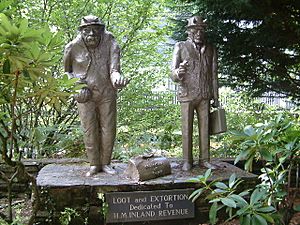Inland Revenue facts for kids

Final logo
|
|
| Non-ministerial government department overview | |
|---|---|
| Formed | 1849 |
| Preceding agencies |
|
| Dissolved | 18 April 2005 |
| Superseding agency | |
| Jurisdiction | United Kingdom |
| Headquarters | Somerset House London, WC2 |
The Inland Revenue was a government department in the United Kingdom. Until April 2005, its main job was to collect certain types of taxes. These taxes included income tax (tax on earnings), national insurance contributions (money for public services like healthcare), and taxes on things like profits from selling assets or money passed down after someone dies. They also collected corporation tax from businesses and stamp duty on property and documents.
More recently, the Inland Revenue also managed special payment schemes called Tax Credits. These included Working Tax Credit and Child Tax Credit. These payments helped families by adding money to their bank accounts or wages. From 1999, the Inland Revenue was also in charge of paying child benefit.
On April 18, 2005, the Inland Revenue joined with another department, HM Customs and Excise. Together, they formed a new, bigger department called HM Revenue and Customs (HMRC). So, the Inland Revenue became a part of HMRC. You might have heard the name "Revenue and Customs" from public announcements on radio and TV.
Contents
The History of Tax Collection in the UK
The way taxes were collected in the UK changed a lot over time. Different groups were in charge of different taxes before they all came together.
Early Tax Boards
The story of the Inland Revenue began in 1665. A group called the Board of Taxes was created. This happened because new taxes were needed to pay for the Second Anglo-Dutch War. A central office, known as the Tax Office, was set up to manage these new taxes.
The Tax Office collected taxes like the Land Tax, which started in 1692. They also collected the window tax and house tax, both from 1696. In 1785, more taxes were added to the Tax Office's responsibilities. These included taxes on carriages, wagons, male servants, and horses. These taxes were known as 'assessed taxes'. They were designed to make wealthier people pay more.
Income Tax was first introduced in different forms starting in 1797. It became a regular annual tax in 1842. Each year, Parliament formally renewed it in a law called the Finance Act.
The Board of Stamps
A separate group, the Board of Stamps, was created in 1694. This board managed stamp duties. These were taxes on official documents and certain goods. Over time, stamp duties were put on many items. These included newspapers, lottery tickets, and even playing cards. They also covered things like hats, gloves, and perfumes. One famous example was the unpopular tax on hair powder. Today, only stamp duty land tax and stamp duty reserve tax remain, and physical stamps are no longer used.
Combining Tax Boards
By 1833, there were fewer different taxes being collected. So, the Board of Taxes and the Board of Stamps were officially combined. This new group was called the Board of Stamps and Taxes. This merger happened under a law passed in 1834.
The Inland Revenue is Born

statues at Trago Mills (near Liskeard, Cornwall), poking fun at the Inland Revenue.
The Board of Inland Revenue was officially created in 1849. This happened when the Board of Excise joined with the Board of Stamps and Taxes. However, the job of collecting excise duties (taxes on goods like alcohol and tobacco) was moved to HM Customs and Excise in 1909.
In 1995, the Inland Revenue wanted to make it easier for people to complete their tax returns. They created a cartoon character called Hector the Tax Inspector. Hector was used in advertising campaigns to help explain the process.
The Creation of HM Revenue and Customs
In 2004, the government announced a plan to merge two big departments. These were HM Customs and Excise and the Board of Inland Revenue. The goal was to create one new department called HM Revenue and Customs (HMRC). This merger officially happened on April 18, 2005. A law called the Commissioners for Revenue and Customs Act 2005 made it possible.
Types of Taxes Collected
The Inland Revenue and its earlier forms collected many different taxes over the years. Here are some of them:
- Land Tax (1692-1963)
- Stamp Duty (1694 onwards)
- Window tax (1696-1851)
- Inhabited House Duty (1778-1834, 1851-1924)
- Legacy Duty (1780-1949)
- Assessed taxes (from 1785), which included:
- Coaches and carriages tax (1746-1798)
- Male servants tax (1777-1852)
- Waggons, wains and carts tax (1783-1792)
- Saddle and Carriage Horse tax (1784-1875)
- Racehorse tax (1784-1875)
- Game tax (1784-2007)
- Female servants tax (1785-1792)
- Shop tax (1785-1789)
- Hair Powder tax (1795-1869)
- Dog tax (1796-1988)
- Clocks and watches tax (1797-1798)
- Armorial Bearings tax (1798-1944)
- Income Tax (1799-1802, 1803-1816, 1842 onwards)
- Succession Duty (1853-1949)
- Corporation Duty (1885-1959)
- Estate Duty (1894-1974)
- Super Tax (1909-1973)
- Excess Profits Duty (1915-1921)
- Profits Tax (1937-1966)
- Excess Profits Tax (1939-1946)
- Capital Gains Tax (1965 onwards)
- Corporation tax (1966 onwards)
- Capital Transfer Tax (later called Inheritance Tax) (1974 onwards)
- Petroleum Revenue Tax (1975 onwards)
The Inland Revenue also collected National Insurance contributions. They managed payments for child benefit and Tax Credits.
See also
- HM Revenue and Customs - the department formed when Inland Revenue merged with Customs and Excise.

